|
It's the last bite of 2017 and I'm happy that I started writing.
Hoping that you will make good plans for 2018. It's common to make fun of New Year resolutions. As a non-follower of Christmas, Hanukkah or other, I'm pretty moved by the New Year. This holiday period is our accepted time for people of all beliefs to rest, gather and connect with family and friends. It loosens inhibitions. I love this. It's very spiritual for me. Why not have a chance to forgive yourself and try again, and again and again? Truisms but... Nothing changes by staying the same and asking is the first stage in getting. Google happiness and there are lots of suggestion on how to define it and or find it. I like it summed up like this... Look after yourself. Cook and read and watch and make and sort and.... Nurture relationships. Keep up contacts. Best way is to cook and trap people around a table. Think of others. Cook for them. Consider what they might need or even crave at the moment. Do something you love. Cook and play and experiment and push the boundaries but stay sane. Live in the moment. Cook what's here for now and also with an eye to the future. Be curious. Cook and play with what might happen if this went with that. This year, make more time to gather together.
5 Comments
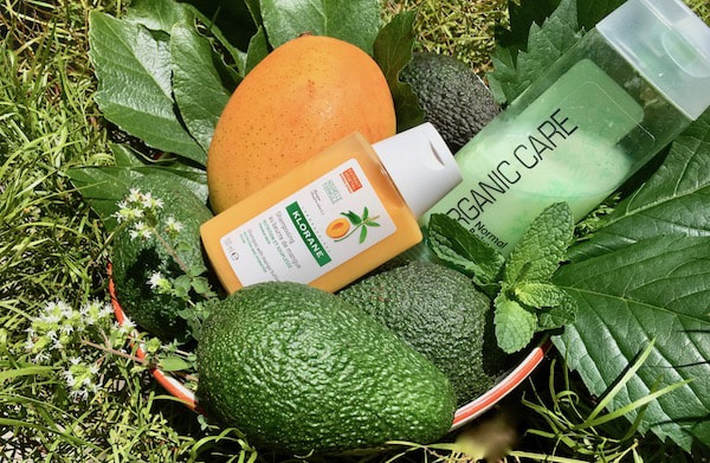 Fruit Bowl for the Bathroom Fruit Bowl for the Bathroom To paraphrase Brillat-Savarin (my hero, along with Mies van der Rohe and Willy Nelson)... "You are what you eat". With so much anxiety and phobia around eating, as well as nutritionism, puritanism and food as pharmaceuticals, it might be less fuss to substitute eating good food with lotions, creams and cleaning products. Perhaps we are not so much what we eat, but now, what we rub on. I have a shampoo with mango butter and a facial spray with cooling lettuce and cucumber. Avocado and almonds are huge in the external "diet", seen in hand cream, face cream, neck cream, eye cream. (I'm terrified one day I'll mistakenly put eye cream on my neck and find eye lashes growing up past my collar line.) Hair, basically "dead" once it's out in the open, gets huge attention with sweet and bitter orange, lime and herbal infusions and romantic tussie-mussies of sage, hyssop and borage. I read these herbs and botanicals have potential health benefits (potential as in Champagne has the potential to make you giggly and light-headed). Shea butter is kept safely outside the body. It's possibly not an "essential" fat. There's the romantic argon oil harvested from nuts excreted by tree-climbing goats, (but as Seinfeld would say, "Not that there's anything wrong with that".) There are spices such as coriander, cloves and cinnamon. (I know someone who is emphatic that the population of India is completely cancer-free because they use turmeric.) Body preparations proclaim their organic ingredients. I use products labelled "Organic-Care" (OK, I like the colour and shape of the bottle.), but that is a brand name not a statement of the growing methods of the ingredients. There's not much organic about cyclopentasiloxane, dimethicone, dimethiconol, amodimethicone, all listed on the label in small print. But then again they aren't the current bad boys. How many users know what a paraben is? Thank goodness they've been outlawed along with comedogenic ingredients and methylchloroisothiazolinone. It's all so marvellously, reassuringly sciencey (sic) - (rather than science based). Nourishing, balancing, revitalising and vitamin rich I am confident my hydrolipidic film is being replenished. I love big words. Kitchen & bathroom cleaners proudly boast baking soda across their visible label, making it sound like something taught in Home Economics - baking soda and borax would clean anything, the girls were told. But reading the ingredient list, baking soda is such a tiny part, leaving the small writing to list the "other stuff", cleaning and sudsing agents, the very ingredients we thought we were avoiding. All these products are in plastic containers. As the planet goes to hell in a hand-basket (or an un-recyclable plastic shopping bag) our desire and need to believe grows stronger. The power of words! In case you didn't know, ciabatta is Italian for slipper, the type of slipper that keeps your feet warm and in which you shuffle, rather than the kitten-heeled, marabou-tuffted sort. The crust is crusty, the loaf is flattish with a small drop in the centre, the interior is soft but slightly chewy with large holes (for trapping thick butter). If you were to have any left over long enough to go stale, it’s perfect for tearing up into a panzanella – half salad, half soup of super ripe tomatoes. It is of course a combination to highlight perfect tomatoes.
In our inner suburban garden, Roger has planted 46 tomato plants, about 6 different varieties in all. Some are from obscure, smuggled seeds and shaped like a large chilli. (If I told you from where, I'd have to kill you.) The ultimate "poster boy" for the destruction of flavour in commercialised food is surely the tomato. The skin is tough, the flesh is acidic, the colour insipid. (I'm sure you're not fooled by what are called "vine-ripened" tomato.) I'm seeing at my local, very good greengrocer, tomatoes of different colours, striped tomatoes and some very gnarly, funny shapes. Some are called heirloom. Unfortunately, even they all taste pretty much the same. So what can you do if you can't grow your own? Doctoring a poor tomato... Let's analyse the symptoms. Tough skin - Removing the skin is easy and really helps. Put a small slash in the skin and drop into water that is just below boiling. Count to three and remove with a slotted spoon and drop into cold water. Skin will come off easily. Really worth doing. Acidic - Picked when unripe (although it may look red & ripe). It hasn't developed its natural sugar. When slicing or chopping for a salad, sprinkle with sugar, perhaps 1/2 tsp for every tomato (or more). Flavourless - as above, lightly salt. Salt highlights flavour and used well, is not the ogre it once was. It also helps soften them. Result - a better tomato. You can call them "confit" tomatoes. Panzanella So simple so perfect but here are some quantities. It's very much a guesstimate sort of recipe and I recommend you keep notes until you can just "sense" it. Per person... 50gm bread, preferably stale ciabatta. You'll soon work out the size of a slice. (Don't go health-foody and use wholemeal IMO, although no-one will really complain.) 150 gm ripe tomato (medium size), peeled if shop bought. 1/4 medium red onion, finely sliced (or substitute similar amount of spring onion) 6 leaves of basil, torn, not cut. (Use more or less, depending on your source.) 1 tsp red wine vinegar & 2tbsp EV Olive oil Seasoning to taste. Cut the bread into small cubes (1.5 cm square, or bigger, or smaller) and lightly dampen with water. Cut the tomatoes (doctored or not) in similar cubes. Keep all juice and seeds. Mix these with the onion. Allow it all to sit and mingle for an hour, so that the tomato juices are soaked into the bread and it's nicely soft. Add the basil, check and adjust the seasoning. Allow to sit for a further 1/2 hour (or more) before serving in a beautiful deep bowl. Needless to say this recipe is very forgiving and flexible. Don't tell the purists but there are suggestions out there of adding a few rinsed capers, chopped anchovies, garlic, leaves of flat parsley, black olives, even, heaven forbid, some cubes of cucumber. (I wouldn't.) The best I've ever tasted, made of course with perfect tomatoes and good bread, came from Gay Bilson, legendary "chef emeritus" and restaurateur of Barowra Waters Inn and Bennelong, someone with impeccable taste buds, where the tiniest cubes of a little celery were added to give crunch. I've stuck to that ever since. Hoping for a beautiful photo in a week's time - not quite enough ripe tomatoes on the vines. *The bread was made by Barbara Santich simply because it's fun and she can. *Roger's tomatoes. What is it about bread? It's so alluring, appetising, aromatic. And it's so photogenic. This is not a recipe blog simply because there are far too recipes out there -thousands of new cook-books every year and an uncountable number on the net. If I want fresh inspiration (or want to keep up with emerging trends) I will trawl through newly published books. If it's a classic or regional dish, perhaps something I've read about in a novel or seen on a program such as Italy Unpacked or Rick Stein - Mediterranean, I go to the net. On the net of course you’ll find everything from the sublime to the ridiculous. Lately, for example, I've enjoyed “researching” the following… Sunshine Salad - Retro Sunshine Salad –read in a novel set in the American mid-west. As my life is lived in a totally retro midcentury modern house, I enjoyed the retro recipe. Note, I enjoyed reading about it, rather than making it. Perhaps one day. Sugee Cake – Sugee Cake – The recipe wherein, to begin, semolina is soaked over-night in melted butter. (I simplified it by using almond meal rather than chopping my own.) This was from an “airplane” novel (you know the sort, thick, hot pink cover, raised gold lettering) – Crazy, Rich Asians by Kevin Kwan. Not only is it fabulous - the book and the cake - (OK, it’s not Pride & Prejudice) but it introduced me to some great food, three forms of architecture and two ceramic traditions I knew nothing about. Timpano (or Timballo) as seen in the film Big Night and described beautifully in the novel The Leopard by Lampedussa. (A recipe I’ll give attention to in the new year.) “The burnished gold of the crusts, the fragrance of sugar and cinnamon they exuded, were but preludes to the delights released from the interior when the knife broke the crust; first came a smoke laden with aromas, then chicken-livers, hard-boiled eggs, sliced ham, chicken, and truffles in masses of piping-hot, glistening macaroni, to which the meat-juice gave an exquisite hue of suède.” But I digress. Now to the bread. Fancy making a loaf without getting your hands sticky, without kneading, just a bit of hanging around? This method, with a 24 hour rising time, was "invented" by Jim Lahey, a NY baker . It was a huge hit and was taken over by scores of bloggers, subtly hinting they may have been the instigator. "Jenny" is such a one and is actually worth watching - no-knead-bread - as she's a bit of a hoot, but below is my adaption, even easier (after you've got the idea from Jenny or Jim). Important - you need a heavy cast iron casserole (or Dutch oven) such as Le Creuset or Staub. 400gm plain flour (any sort - play around) generous 1/4 tsp dry yeast 1 tsp salt 1 2/3 mls (1 2/3 cups) hot water (not boiling) Have ready two similar sized bowls, a tiny bowl and some parchment-type baking paper.
There are more and more great, small artisan bakeries around so why bake some bread? No other reason than you can and it's fun! We could make cheese next time. Why? Because we can and it's fun.
My wife and I enjoy observing different cultures when we travel. At a game reserve in Botswana, women from a near-by village prepared traditional meals at our lodge - a lot of meat dishes (with springbok, warthog and impala wandering around). The table reflected our setting with wonderful dinner plates, hand-made by a local potter and napkins in the shape of an Africa animal. (The one in the photo is an elephant, possibly more striking in real life!) I know that this borders on the ‘fan in the glass’ style but it suited the occasion perfectly. Williamsburg in Virginia, is a recreated a village. It is the largest living history museum in America, depicting life in the 1780s during the formative years when the colony became the United States of America.
We admired the napkins used in the 18th century when we ate at the seafood restaurant, Christiana Campbell’s Tavern. They serve such dishes as Catfish Stew and Clam Chowder. Not only were the crockery, cutlery and food in the style of the 1780s but also the napkins. They were over 1 x 1 metre square and were worn tied around the neck. (See Jenny as she prepares to eat her dish of shrimps.) Note the correct way in which she holds her knife and fork. She has never forgotten as a child when her father threatened to sticky-tape her index finger to the fork. Madame Bollinger is purported to have said, “I drink Champagne when I'm happy and when I'm sad. Sometimes I drink it when I'm alone. When I have company I consider it obligatory. I trifle with it if I'm not hungry and drink it when I am. Otherwise, I never touch it -- unless I'm thirsty.”
We are on the new direct flight to Hobart with Jetstar. We are squashed but quite comfortable at the front of the plane, having a warm chardonnay sparkling in a plastic. Living high, we snack on a cashew-sesame “Munch”. I think of Mme Bollinger. The packet tells us we can enjoy “Munch” alone, with company, after a work-out, after yoga or gym, when we’re hungry or as a snack, on a morning break or even in the afternoon. I guess a plane is OK also. It's versatile. Furthermore, we’ll know we are looking after ourselves. Wow! It must be good. “Eat something decent. Tear here," says the packet. “Munch” comes in a no-nonsense plastic pack and consists of neat squares of what looks like a standard nut “health” bar. It’s OK but, as Rowen Atkinson said in Love Actually, it is oh so, so, so much more. I learn… It is all natural, vegan & nutritious with a 4 star health rating. It contains 0% dairy, honey, cholesterol, trans fats, gluten or artificial additives. In a word (or several) it’s all wholesome nutrients for body and mind. It is a guilt-free recharge (good for those who feel a lot of guilt, I guess). It is artisan-crafted and kitchen-crafted using centuries-old methods (love those centuries) - whole-food nutrition & inherent goodness with custom-made rice malts and flavours that nature intended. Antioxidant-rich berries along with other goodies like fats (Not ordinary fats! No! Essential fats i.e. fats that are essential!) lift both you and your spirit. Artificial additives & preservatives are banned. It is made in China from imported and local ingredients (Imported? Where?) - this from the country that sells live-plucked feathers and down for doonas/duvets. You are challenged to "Eat something decent. We’ve done the thinking for you and you’ll know you’re looking after yourself.” And, all of this information can be found on one tiny flat packet 10cm x 16cm. Wow -the power of words! 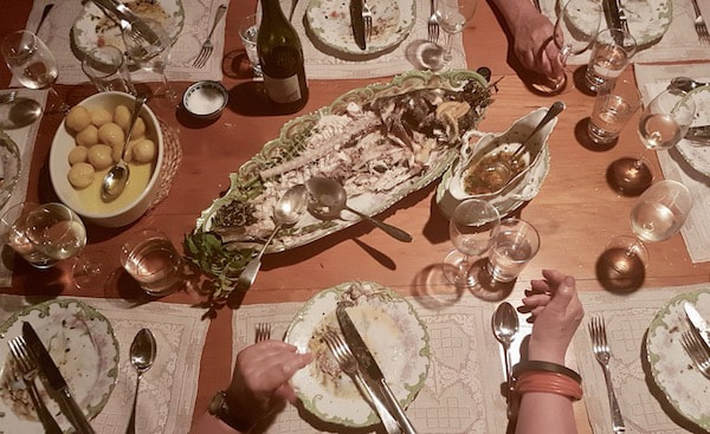 The occasion was really to celebrate the 19th century fish service; 12 plates, a long platter and a sauce boat. This has been sitting in a glass-fronted cabinet in a room of Barbie’s rambling house, set in possibly Hobart’s best garden. We were there for a four-day break. I cooked a simple dinner, trying to put as little pressure as possible on the kitchen. Fortunately, Tasmania has a thriving food scene. We started with half capsicums stuffed with cherry tomatoes of many colours, thyme sprigs and feta, roasted with local olive oil. Next was the pièce de résistence, a whole Blue-Eye Trevalla pre-ordered from the local fishery. This went with creamy pink-eye potatoes and sauce vierge. Apart from the fish plates themselves, the hit of the night was the sauce. (See below.) We finished with an extravagant Pavlova and huge, perfumed strawberries. The evening was meant to be easy so I bought the Pavlova base. (There I’ve said it!) With tons of cream on top, deep red, sliced strawberries and passion-fruit pulp, no one could believe that I’d bought the base. I should have kept quiet. Sauce Vierge There are many versions on the net (Jamie Oliver, Marco Pierre White, Gordon Ramsay, Michael Guérard, even the Irish Times) but this is what I did, because the herb garden held an embarrassment of riches. The sauce will turn fish, scallops, chicken, beef fillet, cauliflower, haloumi, anything into a masterpiece. For eight people (Quantities of ingredients are very “flexible”. Chop, then measure.) 150 ml EV olive oil 3- 4 ripe tomatoes, in tiny dice (Keep juice & seeds) 1/3 cup finely chopped shallots or red onion 2 tbsp rinsed small capers ½ cup chopped herbs (I used tarragon, marjoram, chives. I could have also used basil or parsley – all together or singly.) Mix all together and check if you’d like seasoning – salt or even a splash of sweet vinegar (I won’t call it balsamic) or brown sugar (depending on the tomatoes). It will sit patiently until you need it. The fish service is unmarked but probably French, 19thC. It is wonderfully vulgar with an acid green edge, pink orchid-like flowers and realist underwater scenes of different fish, seaweed and anemones. The sauceboat is very OTT. Very petit bourgeois. We all adored it and I’m sure the service was happy to have come out of seclusion for the evening. The Calm Before The Fish This is certainly not the perfect table setting.
One wouldn't put the cup, saucer and teaspoon out until the end of the meal and why would the teaspoon be placed between the knife and the soup spoon? The preferred cutlery with the dessert spoon would be a dessert fork rather than a cake fork and I'd like to see them tidied up, more tightly together above the dinner plate. IF I were offering bread, I'd probably suggest the B & B plate lower on the left. (The napkin could even possibly be placed on this plate, leaving more room for the phone.) The phone is nicely positioned for easy reach BUT as Tony Brooks (Heirloom Wines, father of Zar Brooks, Dandelion Wines) asks... at home, where do you place the remote? 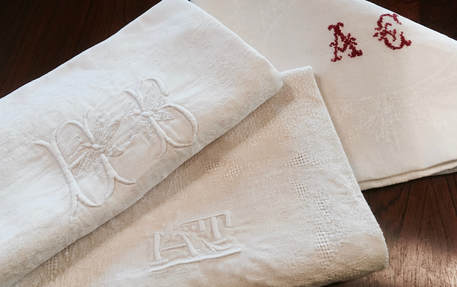 Someone has asked which is correct, napkins or serviettes. There is no correct, right or wrong but there’s a story (of course) leaving you to decide. With the Industrial Revolution (late 18th C.) a strong, emerging and visible middle class took on some new vocabulary to sound more genteel and “refained”. The humble napkin became serviette, from the French. It all backfired when in the 1950s a study and thesis highlighted words and expressions seen as class delineators in the English language, words that had been adopted originally to sound “naice” but were seen as trying too hard. Much was made of a printed list of some words identifying the differences between U and non-U language (upper class and non-upper). Serviette is at the top of the list as a class delineator, along with lavatory (posh) instead of toilet (twee). (It makes for interesting reading.) So some words are posher (although the term posh is not posh, unless it’s used ironically). In the main, “smart” vocabulary is more down to earth and Anglo- Saxon, and “refained” words (strangely often taken from everyday French) are what my father would have called “bungin’ on side”, trying too hard to be “naice” and sounding rather twee It was all meant to be light hearted but some took it very seriously. Some examples… Posh Twee and “refained” U’s sweat They perspire U’s are rich They are wealthy U’s eat vegetables They eat greens U’s wear scent They wear perfume U’s die They pass U’s have jam They have preserves What? Pardon? House Home I don’t want to be posh or not posh but I prefer the old, down to earth language, calling a spade a spade. Sadly friends die. You can’t hide it by saying they have passed. I’ll share with you the word that most makes me cringe. It's “home” instead of “house”, especially a “home with drapes” rather a “house with curtains”. “She has a beautiful home” (rather than a nice house) is enough to make me pass out with rage. (The real-estate business has a lot to answer for.) Many so-called "rules" are merely suggestions for a civil society and are more often than not based on sense and sensibility.
In an Italian restaurant recently, a friend noticed one of their group heaping dressed salad onto his linguine al fungi. Yes, he's allowed to but had it not occurred to him that he's placing cold onto hot, and that the dressing of the salad would blend nastily into the pasta's sauce and that there was ample time to savour the pasta then cleanse the palate by eating the salad? There's time - it's not the last supper. We talked about food combos that make us cringe, cringe as cooks, cringe as defenders of food culture and cringe as eaters who think about how things work best. Italians suggest, no grated cheese (be it Parmesan or Pecorino) on a seafood pasta. Common sense suggests no side order of chips with a lasagne. Common sense suggests that bread is not a pre-prandial nibble. (Nice words, 28 October, 2017) My (French) mother suggested that soup was never served as part of a luncheon menu, unless it was a fish soup. (Whacky, but the concept has served me well.) Taking more than you can eat and leaving it on the plate for "Mr Manners". We could add to this list. But of course, as a Rugged Individualist, you can plough ahead regardless, piling your plate high at a buffet, even though you can change your plate as often as you like. It's not the last supper. And you are free to eat as you choose. My absolute cringe I witness often, unfortunately. A beautiful cake or the perfect pastry on a pie is slathered too often with pouring of cream, custard (or crème anglaise) all over the TOP. Uuuugh! Horror! Now, I'm not for a moment suggesting you stint on the cream or custard. Pour on, Macduff. But try this; pour the accompanying sauce lavishly AROUND the cake or tart. As you cut into it, your spoon will scoop up some sauce and both will come together nicely in your mouth, leaving the top of the cake or tart looking still beautiful -not drowned. Respect. What are your food combo cringes? |
Categories
All
|
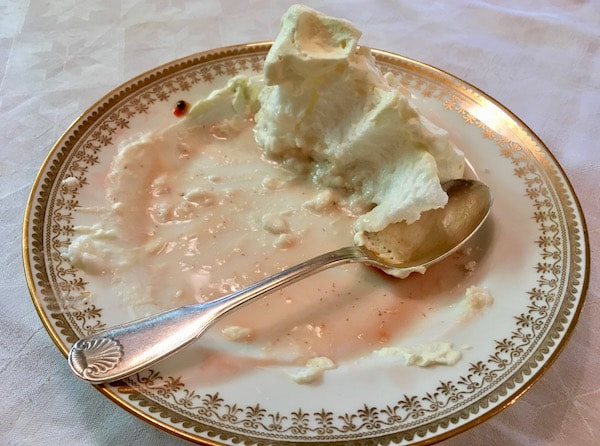
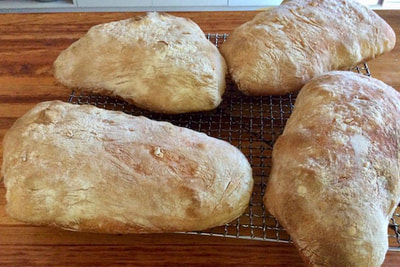
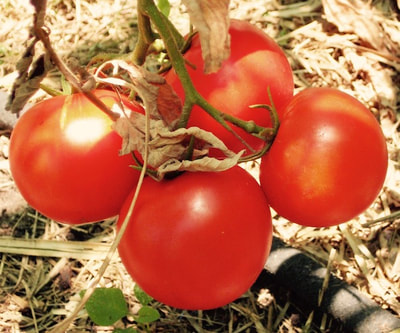
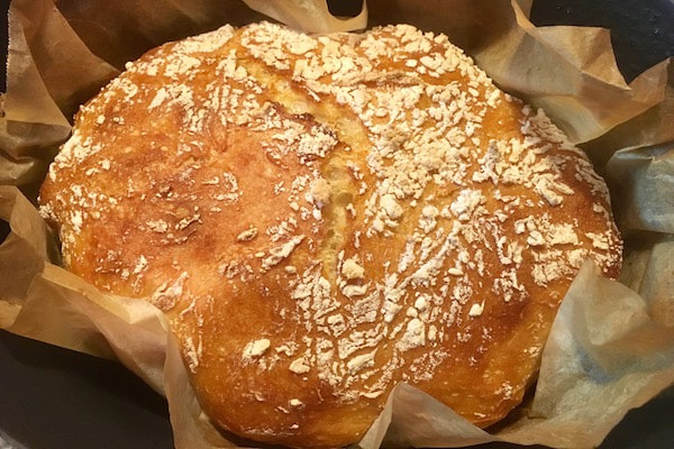
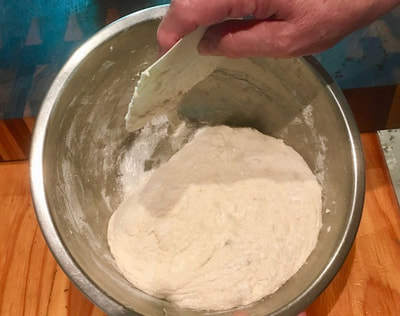
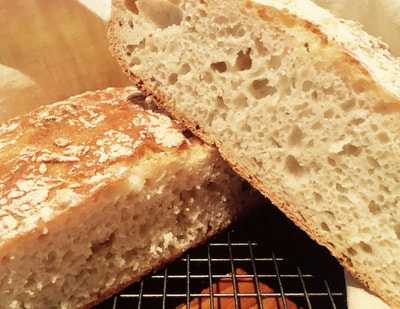
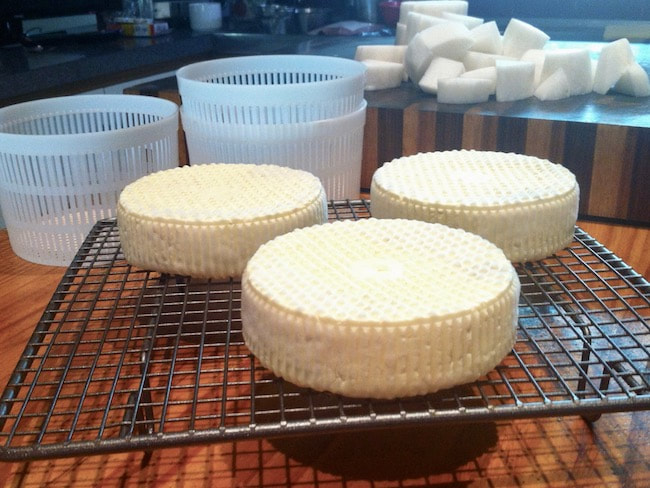
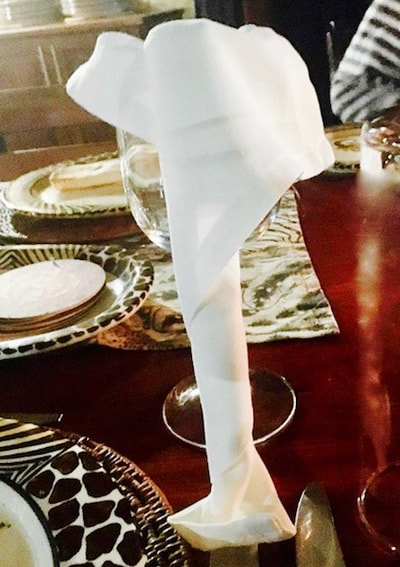
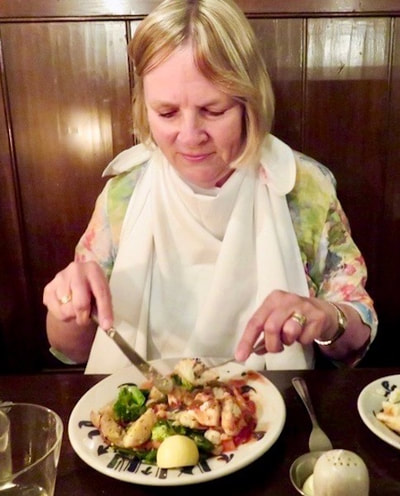

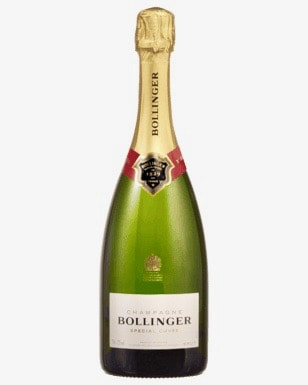
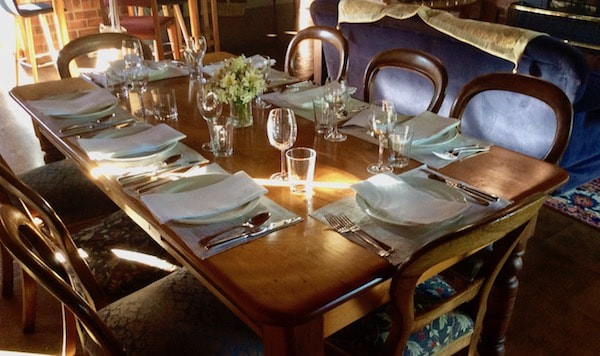
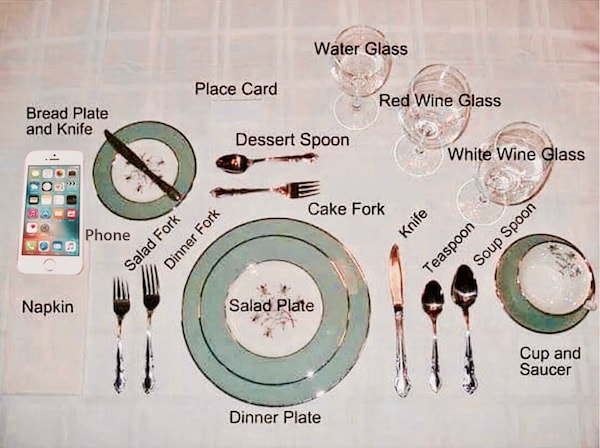
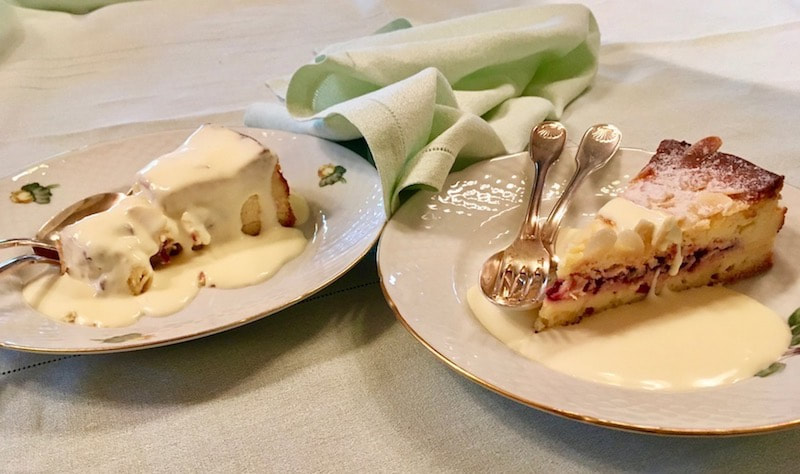
 RSS Feed
RSS Feed
